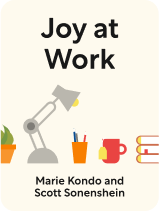

This article is an excerpt from the Shortform book guide to "Joy at Work" by Marie Kondo and Scott Sonenshein. Shortform has the world's best summaries and analyses of books you should be reading.
Like this article? Sign up for a free trial here.
Are you drowning in a sea of workspace clutter, endless emails, and back-to-back meetings? How can you find meaning in your work?
In Joy at Work, tidying expert Marie Kondo and organizational psychologist Scott Sonenshein reveal how decluttering your workspace can dramatically boost your productivity and happiness. They help you eliminate distractions, reclaim control over your workday, and rediscover meaning in your professional life.
Continue reading for an overview of the book, complete with practical exercises.
Joy at Work Overview
Drowning in a sea of workspace clutter, endless emails, and back-to-back meetings? Joy at Work offers a lifeline. Marie Kondo and Scott Sonenshein adapt Kondo’s KonMari Method to transform your professional life through the intentional tidying of your physical space, digital environment, time, and relationships. This guide explores how workplace tidying addresses today’s overwhelming professional challenges by applying methodical, joy-based decision-making to every aspect of work.
Kondo is a renowned tidying expert and the author of the best-selling book, The Life-Changing Magic of Tidying Up. The book, which encouraged readers to only keep items that “spark joy,” started a global decluttering movement and spawned a Netflix series. In this book, Kondo teamed up with Sonenshein, an organizational psychologist and author of Stretch, to apply the KonMari Method to workplaces.
In this guide, we’ll explore the philosophy behind the KonMari methodology with its focus on joy-based decision-making. We’ll then dive into tidying techniques for physical workspaces and digital environments before extending these principles to more abstract aspects of work like time management, meetings, decision-making, teams, and professional networks. Finally, we’ll examine how individual tidying efforts can transform both personal fulfillment and organizational culture, creating ripple effects that extend far beyond your desk.
We’ll supplement the authors’ advice with insight on the psychology behind tidying, research on workplace well-being, and practical strategies from workplace productivity experts like Cal Newport (Deep Work) and organizational psychologist Stewart Friedman (Leading the Life You Want).
A Philosophy of Tidying
In this section, we’ll discuss why tidying matters in professional contexts and outline the basic principles of the KonMari Method. These principles set the stage for the practical applications that follow.
The Case for Workplace Tidying
It’s easy to feel overwhelmed at work, whether by the clutter in your office, the neverending flood of emails, or back-to-back meetings that eat up your workday. According to Kondo and Sonenshein, tidying has the power to transform your work life, leading to greater productivity, joy, and job satisfaction.
The authors point out that clutter, both digital and physical, overwhelms your brain and makes it harder to enjoy your work. Research shows that messy environments affect both individuals and organizations. On an individual level, clutter increases cortisol (your body’s stress hormone), which can lead to depression, stress problems, and poor decision-making, resulting in a decrease in both productivity and happiness. Consequently, organizations bear the cost of wasted time when employees work inefficiently. Therefore, tackling clutter can increase workplace well-being and productivity.
The authors stress that the goal isn’t achieving a stereotypically tidy desk or empty inbox, but creating a personalized space that encourages you to focus on meaningful work and restores purpose and satisfaction in your professional life. The authors emphasize that tidying goes beyond mere organization—it’s a reflective dialogue with yourself that helps you rediscover your values, aspirations, and preferred working styles.
The KonMari Method of Tidying
The KonMari Method, developed by Kondo and adapted for professional settings with Sonenshein, offers a systematic approach to creating and maintaining an organized workspace. Unlike conventional organizing strategies, which typically focus on storage solutions and short-term cleanup efforts based on locations or categories, this method focuses on transforming your mindset and encouraging joy-based decision-making to achieve lasting results.
Kondo and Sonenshein break down the method into three steps.
Step #1: Visualize
The authors recommend visualizing your ideal work life as an important first step in the KonMari process: Imagine your physical environment and how you want to feel at work, including specifics of your daily routine. They argue this mental blueprint motivates you and gives you a concrete target for your tidying efforts. According to the authors, people often fail to maintain a tidy workspace because they haven’t established clear, meaningful goals or understood their deeper motivations. Without this foundation, even well-intentioned tidying efforts collapse under everyday pressures.
Step #2: Keep What Sparks Joy
Next, the authors say you should use “joy” as the main criterion for what to keep. They describe joy as a physical sensation—a little thrill or flicker of excitement when you touch an item that truly resonates with you. In a professional context, this might mean appreciating how well a tool functions or recognizing how an item supports your work goals.
While in the home context Kondo recommends keeping only items that spark joy, she and Sonenshein recognize that workplaces contain necessary items like tools and documents that may not spark personal joy but are essential for professional functions. Thus, in a professional context, they recommend sorting items into three categories: those that spark joy (items that genuinely excite you, like a favorite pen or meaningful award); those that have “functional joy” (items that may not thrill you but effectively support your work, like well-designed software or reliable equipment); and those that have “future joy” (items that contribute to your long-term goals and aspirations, such as professional development materials).
Step #3: Tidy All At Once
Kondo and Sonenshein emphasize the importance of tidying in one focused effort rather than spreading out your tidying sessions. Piecemeal approaches typically lead to rebounding clutter, whereas tidying in one go helps you establish clear systems. They recommend setting aside specific time for a “tidying festival”—a concentrated period dedicated to organizing your workspace completely. This prevents the common cycle of partial tidying followed by gradual clutter accumulation. In shared workspaces, Kondo suggests choosing times—such as early morning or after hours—when you won’t disrupt colleagues.
Practical Tidying Tips
The KonMari Method requires that you decide what to keep before you determine where to store it, creating lasting order by ensuring everything serves a purpose. Instead of tidying by location (for example, drawer by drawer), Kondo’s approach requires you to tidy by category, which builds your decision-making skills as you progress through each category. This section explores the authors’ tips for tidying different aspects of your work life, from your physical workspace to your inbox, time, and professional networks.
How to Tidy Your Physical Workspace
When you tidy your physical workspace, the authors recommend beginning with items for which you have sole responsibility, and focusing primarily on your own workspace instead of communal ones.
For those working from home, the authors emphasize the importance of clearly distinguishing between work-related and personal items, and focusing only on work-related items during this process.
Kondo and Sonenshein reiterate that order and method matter in the tidying process. They suggest following the KonMari Method’s specific sequence: books, papers, komono (miscellaneous items), and sentimental items, treating each category with care and focus, completing one before moving to the next.
Books
When tidying books, the authors suggest gathering all books in one spot and handling each one individually to decide what truly brings joy or serves a current purpose. They explain that this process also often reveals shifting personal interests and values, helping you recognize which books continue to serve you and which you can let go. Books that no longer contribute to your work or personal growth can be respectfully released.
Papers
For papers, Kondo and Sonenshein explain that the goal is to discard as much as possible, especially given digital alternatives. They recommend dividing papers into three categories: pending items that require action, documents you need to save, and documents you want to save. According to the authors, storing papers upright (in filing systems or organizers) improves visibility and prevents forgotten documents.
Komono
In the KonMari Method, komono encompasses all miscellaneous items—pens, office supplies, business cards, and snacks. Kondo and Sonenshein suggest dividing these into logical subcategories, focusing on work tools, personal care items, and food. When sorting workplace food items (condiments, disposable utensils, snacks, tea), keep only what supports your daily needs without cluttering space.
Also, be realistic about quantities—the authors emphasize that most professionals need far fewer supplies than they typically keep.
Kondo and Sonenshein provide three fundamental rules for desk storage: Designate a specific place for each item, store similar items together (for example, all pens in one place, stationery in another), and keep the desk surface clear. They recommend using boxes for drawer organization and, as with papers, upright storage to maximize space and visibility.
Sentimental Items
Sentimental items present the final hurdle in workplace tidying. The authors advise handling this category last when you have more practice deciding what sparks joy for you in the workplace. When evaluating these items, consider the joy or future purpose of each sentimental piece, making clear distinctions between what belongs at work and what should be taken home.
Sentimental items might also include those that personalize your workspace. The authors explain how adding “joy-plus” touches—items that simply make you happy rather than serving a specific function—can significantly enhance your daily experience. These might include photos, plants, crystals, or thematic decorations that make your workspace uniquely yours. The authors suggest approaching tidying as interior designing, transforming it from a chore into a creative endeavor that expresses your personality and supports your working style.
Establish Daily Rituals
The authors recommend establishing a daily ritual to maintain your tidied workspace and cultivate a positive mindset. They suggest starting each day with a brief cleaning ritual, wiping your desk and expressing gratitude for the tools that support your work. This simple practice can transform your workspace into a place that generates positive energy and enhances creativity. Kondo shares how her own brief morning cleaning ritual at her former company visibly improved her sales performance and professional recognition.
The authors write that these maintenance rituals serve as a bridge between the initial tidying festival and long-term habits, ensuring that your workspace continues to support your productivity and well-being. Dedicating just a few minutes each day to these practices can help you prevent clutter from accumulating and maintain the clarity and focus that comes with a well-organized environment.
How to Tidy Your Digital Workspace
While physical clutter might be immediately visible and therefore distracting, Kondo and Sonenshein argue that less visible digital clutter can be equally overwhelming and disruptive to productivity. Emails, files, notifications, and virtual meetings create a significant mental burden even when hidden within devices. The authors’ digital tidying philosophy emphasizes gaining control over technology rather than letting it control your workday. They give tips for tidying documents, email, and applications.
Digital Documents
When tidying digital documents, Kondo and Sonenshein advise applying the same principles as physical paper: Keep only essential files and discard unnecessary ones. The authors also recommend that you organize digital files into a few main folders to simplify retrieval, and use search functions rather than creating complex hierarchies.
Kondo and Sonenshein emphasize taking control of your inbox to prevent it from dominating your work life. They recognize that email is a significant source of workplace stress and clutter for many professionals. They advocate implementing a daily processing system to avoid accumulation. When deciding which emails to keep, consider their necessity for future tasks, their potential for inspiration, and whether they spark joy. As with digital documents, use a simplified folder system, aiming for 10 or fewer folders including subfolders.
Applications
The authors recommend reducing apps to only those essential for your job, those that aid job performance, and those that genuinely spark joy. Organize remaining apps into categories based on frequency of use or purpose, while regularly reviewing and deleting dormant apps to maintain your focus and optimize device performance.
How to Tidy Other Aspects of Work
Beyond physical and digital spaces, Kondo and Sonenshein extend their tidying philosophy to other crucial aspects of professional life, including time management, meetings, decision-making, work teams, and your broader professional network.
Time Management
Kondo and Sonenshein identify “activity clutter”—unnecessary meetings and tasks—as a primary factor diminishing work satisfaction and productivity. They highlight three psychological traps affecting time management:
- The overearning trap (working toward goals that don’t align with your values)
- The urgency trap (prioritizing urgent tasks over important ones)
- The multitasking trap (decreasing productivity due to divided attention)
To effectively evaluate your tasks, the authors recommend organizing all activities into three categories—core, project, and developmental—and evaluating each based on necessity, immediate joy, and potential for future joy. Tasks failing to meet these criteria should be discarded when possible. They suggest examining who benefits from each task by asking yourself: “Who receives value from this work? My organization, my colleagues, my customers, or myself?” This helps you identify and eliminate tasks that don’t contribute to important outcomes. The authors encourage embracing the power of saying no to tasks that don’t align with personal or professional goals, allowing you to reclaim control over your time and workload.
Kondo and Sonenshein also suggest incorporating daily joy and scheduled downtime into work routines. Activities that spark joy enhance overall work satisfaction, while downtime is crucial for creativity and productivity. For example, start your day drinking coffee from your favorite mug, take five minutes to catch up with a colleague whose company you enjoy, listen to music that helps you work and makes you happy, or take a short walk outside periodically throughout the day. The authors emphasize that these small moments of joy, when deliberately integrated into your daily routine, create cumulative positive effects on your work experience and performance.
Meetings
Meetings are often cited as one of the biggest time drains in the workplace. Kondo and Sonenshein argue that not all meetings are necessary, and recommend regularly evaluating meetings using the following criteria to make sure they need to happen: whether they’re relevant to your job, contribute to your ideal work life, and bring joy. The authors recommend, when possible, to only attend meetings that meet these criteria, while also considering the organization’s needs and expectations and what you can contribute to a meeting. If you decline to attend a meeting, do so politely by requesting a clear agenda or offering a brief explanation for your absence.
When you do attend a meeting, focus on being fully present, prepared, and respectfully engaged. For meetings you lead, be respectful of other people’s time: Ensure clear objectives, include only essential participants, encourage active participation, and maintain strict timeframes. The authors also recommend concluding meetings by summarizing achievements and outlining next steps to reinforce purpose and accountability.
Decision-Making
According to Kondo and Sonenshein, making choices consumes a lot of our mental energy in the workplace. They identify three types of decisions we make daily and recommend how to approach them to manage decision fatigue:
1. Low-stakes decisions: The majority of daily choices that are typically made automatically but can collectively drain mental energy (like what to wear or where to eat lunch). The authors recommend automating or minimizing these decisions when possible (creating routines for daily choices).
2. Medium-stakes decisions: Common choices with direct impact on work quality and efficiency that are often overlooked, like how to structure a presentation or prioritize weekly tasks. The authors recommend creating efficient systems for handling these types of decisions by using templates or decision frameworks.
3. High-stakes decisions: Rare but crucial choices that require considerable mental resources (like accepting a job offer or launching a major project). The authors recommend reserving your mental energy for these decisions.
To further simplify your decision-making process, eliminate unimportant choices, delegate decisions where appropriate, and limit options to prevent decision overload. Kondo and Soneshein say that rather than seeking perfection in every decision, aim for “good enough” solutions, recognizing that you can adjust many decisions later if needed.
Teams
Tidying teams is about creating purposeful, joyful groups that enhance both individual and group effectiveness. When considering what teams you should be a part of, the authors recommend evaluating which teams will benefit from your unique skillset and align with your professional goals. By distinguishing between teams that leverage your strengths and those that don’t, you can make more intentional choices about where to invest your time and energy.
The authors emphasize that trust is an important part of any functioning team. Whether leading or participating in a team, encourage mutual support and open communication. Personal conflicts should be addressed promptly to prevent toxicity and maintain focus on collective goals. When disagreements inevitably arise, Kondo and Sonenshein recommend addressing them directly. They suggest encouraging diverse viewpoints, arguing that they lead to stronger outcomes while avoiding groupthink.
Finally, the authors suggest keeping teams small because research suggests smaller teams are more productive and more satisfying for team members. The authors advocate following the “two-pizza rule” (if two pizzas can’t feed the team, it’s too large).
Your Network
Kondo and Sonenshein approach professional networks with the same discernment they apply to physical objects, focusing on quality over quantity. They challenge the misconception that larger networks indicate greater success, emphasizing that meaningful connections matter more than accumulating as many contacts as possible. Research suggests humans can reasonably manage about 150 meaningful relationships, with most interactions coming from a small subset.
The authors recommend resetting your network to include only joy-sparking relationships, creating more time for meaningful interactions. Evaluate connections by asking three questions:
- Which connections do I need for my job?
- Which can help advance my work-life vision?
- Which connections bring me joy?
The authors emphasize building genuine connections over passively maintaining a network of contacts. They suggest four ways to strengthen relationships you want to keep: First, be present when you talk with people—put your phone away, listen actively, and respond with questions. Second, find ways to help others do their best work, whether that’s sharing a useful resource or giving honest feedback. Third, don’t be afraid to be vulnerable with colleagues. For example, admit when you’re struggling with a project or share personal wins. And finally, be playful in your interactions—share a funny story, have an impromptu brainstorming session, or take a walking meeting instead of sitting in a conference room. These small changes can transform work relationships from transactional to meaningful.
The Exponential Power of Tidying
Beyond tidying the physical and digital elements that make up your day-to-day work life, the authors’ approach also helps you clear mental clutter so you can focus on your deeper purpose and positively influence the people around you. This section explores how to assess your overall work situation, maintain work-life balance, and find meaning in your role to create ripple effects that extend beyond your immediate workspace.
Assess Your Current Work Situation
If you’re dissatisfied with your job, Kondo and Sonenshein recommend conducting a thorough self-assessment before deciding to change jobs. You can do this by creating two lists: 1) what energizes you, and 2) what drains you at work, examining everything from core responsibilities and daily routines to workspace dynamics and colleague relationships.
Look for patterns in your dissatisfaction—specific meetings, tasks, or interactions that consistently diminish your enthusiasm. The authors emphasize that this inventory often reveals targeted adjustments to specific pain points that can significantly improve your work experience without requiring a complete career change, much like reorganizing your desk rather than moving offices. They recommend you consider changing jobs only if these focused improvements don’t resolve your underlying dissatisfaction.
Maintain Work-Life Balance
As your tidying practice deepens, you’ll become more discerning about how you spend time and energy across all areas of life. The authors recommend periodically evaluating your work-life balance by visualizing your ideal state—just as you did with your workspace—then adjusting your schedule accordingly. Work-life balance, like a tidy workspace, requires regular maintenance and adjustment as your priorities shift with changing career and personal circumstances. What works during busy project periods may need modification during calmer times, ensuring your professional tidying efforts support rather than undermine your overall well-being.
Find Purpose
The authors argue that every job contributes meaningfully to society when you connect your daily tasks to their larger impact—understanding how your work serves customers, colleagues, or broader community needs. A software engineer might find purpose knowing their code helps millions of users stay connected with loved ones, while a janitor might take pride in creating clean environments that boost everyone’s productivity and well-being. The authors suggest regularly asking yourself: “Who benefits from my work, and how does it make their lives better?”
This shift in perspective creates ripple effects throughout your organization. When you approach work with a clear purpose and organized systems, colleagues notice your efficiency, positive attitude, and intentional choices, often adopting these practices themselves. This transformation becomes self-reinforcing as collective improvements enhance team productivity and workplace culture, making your own work environment more satisfying and effective.
Exercise: Tidy Up Your Physical and Digital Workspace
Kondo and Sonenshein present several strategies for decluttering your physical and digital workspaces to create an environment that supports productivity and sparks joy. This exercise will help you apply the KonMari method to your professional environment.
- Think about your current physical workspace. What aspects of it make you feel stressed, overwhelmed, or distracted? List at least three specific issues that interfere with your ability to work joyfully and efficiently.
- Visualize your ideal workspace. What does it look like? How does it feel to work there? What activities flow more smoothly? Be as specific as possible about the environment you want to create.
- Think about the maintenance rituals Kondo and Sonenshein recommend. What brief daily practice could you implement to maintain your tidied workspace and cultivate a positive mindset? Include details about when you’ll practice this ritual and how you’ll remember to do it consistently.
Exercise: Tidy Up Your Time and Relationships
Kondo and Sonenshein explain that applying the KonMari philosophy to your activities, decisions, and professional relationships can lead to greater fulfillment and effectiveness at work. This exercise will help you identify and address these less tangible forms of workplace clutter.
- Consider your “activity clutter”—the meetings, tasks, and obligations that fill your workday. Name one specific activity that consistently drains your energy and explain why you think it feels burdensome.
- Identify one professional relationship that energizes you. What specific quality makes the energizing relationship valuable to you?
- Select one area of your work life (time management, decision-making, meetings, or professional relationships) that would benefit most from tidying. What single, small action could you implement this week to reduce this type of clutter?

———End of Preview———
Like what you just read? Read the rest of the world's best book summary and analysis of Marie Kondo and Scott Sonenshein's "Joy at Work" at Shortform.
Here's what you'll find in our full Joy at Work summary:
- How decluttering your workspace can boost your productivity and happiness
- How to apply the KonMari Method to every aspect of your professional life
- Why tidying mental and digital spaces is just as important as physical spaces






